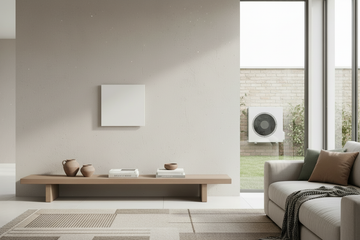Infrared Heating vs Ground-Source Heat Pumps: which saves more energy in the UK?
Infrared Heating vs Ground Source Heat Pumps: Which Saves More Energy?
Infrared heating and ground source heat pumps (GSHPs) are both positioned as energy efficient alternatives to traditional gas heating, but they reduce energy use in very different ways. Ground source heat pumps aim to lower electricity consumption per unit of heat through seasonal efficiency, while infrared heating focuses on reducing total energy demand by heating people and surfaces directly rather than warming large volumes of air.
Which system saves more energy depends heavily on property type, usage patterns, installation complexity, and how the building is actually heated day to day.
How ground source heat pumps save energy
Ground source heat pumps work by extracting low grade heat from the ground and upgrading it to a usable temperature for space heating. Because they move heat rather than generate it directly, they can deliver more heat energy than the electricity they consume.
In well designed systems, a ground source heat pump may achieve a seasonal coefficient of performance (SCOP) of around 3 to 4. This means that for every unit of electricity used, the system can deliver approximately three to four units of heat.
This efficiency is most effective when:
- The property is well insulated
- Heating is required continuously throughout the day
- Low temperature emitters such as underfloor heating are installed
- The system is correctly sized and professionally designed
However, ground source heat pumps typically involve high upfront costs, ground works, and significant disruption during installation.
How infrared heating saves energy
Infrared heating works in a fundamentally different way. Instead of heating air, infrared heaters emit radiant energy that warms people, walls, floors, and furnishings directly.
This approach reduces energy use by:
- Delivering warmth instantly without preheating air
- Reducing heat loss caused by air movement and stratification
- Allowing rooms to be heated independently
- Maintaining comfort at lower air temperatures
While infrared heaters operate at a one to one electricity to heat ratio, many properties use fewer total kilowatt hours because heating is applied only where and when it is needed.
For a detailed breakdown of electricity usage, see our guide on how much infrared heating costs to run in the UK.
Infrared vs ground source heat pumps: real world energy use
On paper, ground source heat pumps often appear more energy efficient due to their higher SCOP values. In practice, total energy use depends on how the building is heated.
When ground source heat pumps often use less electricity
- Well insulated homes with continuous all day heating
- New build properties designed around low temperature systems
- Homes already investing in major retrofit works
When infrared heating often uses less total energy
- Homes heated room by room rather than continuously
- Properties with high ceilings or draughty spaces
- Extensions, loft conversions, and retrofits
- Churches, halls, workshops, and heritage buildings
In these scenarios, heating the entire building via a central system can result in significant wasted energy, whereas infrared heaters deliver warmth directly to occupied areas only.
Installation and disruption
Installation requirements differ significantly between the two systems.
- Ground source heat pumps require ground excavation, boreholes or trenches, internal plant equipment, and system integration. Installation costs are typically high and disruption is unavoidable.
- Infrared heating requires no pipework, no ground works, and no combustion. Panels can be installed room by room with minimal disruption.
This difference makes infrared heating particularly attractive for existing buildings and phased upgrades.
Maintenance and long term reliability
Ground source heat pumps contain mechanical components that require periodic servicing to maintain performance and warranty compliance.
Infrared heaters contain no moving parts, require no servicing, and typically offer long operational lifespans with minimal maintenance.
Which system is right for your property?
If your property is well insulated, requires constant whole house heating, and you are prepared for significant upfront investment, a ground source heat pump may offer lower electricity use per unit of heat.
If your property is used intermittently, has varied room usage, or requires targeted heating, infrared heating can often deliver lower total energy consumption and greater control.
You may also wish to compare infrared heating against other systems in our infrared heating vs traditional heating guide.
Calculating the correct system size
Energy efficiency depends heavily on correct system sizing. Oversized or undersized systems will waste energy regardless of technology.
You can estimate the correct heater output for each room using our room based wattage calculator.
Industry insight: We regularly advise customers comparing infrared heating with heat pump systems, particularly in retrofit and non-standard buildings. This experience informs our comparisons, focusing on how systems perform in real UK properties rather than idealised conditions.
Conclusion
Infrared heating and ground source heat pumps reduce energy use in different ways. Heat pumps improve efficiency by multiplying heat output, while infrared heating reduces demand by targeting warmth directly where it is needed.
The most energy efficient solution depends on how a building is used, not just on theoretical performance figures. Understanding these differences allows homeowners and businesses to choose a system that delivers real world energy savings.
For further comparisons, you can also read infrared heating vs heat pumps: running costs compared.
Next steps: choose the right infrared heating
Continue with one of these popular options:
- Shop All Panels, accessories & bundles.
- Wattage Calculator Get the right watts for your room.
- How Infrared Works Benefits, costs & installation.






